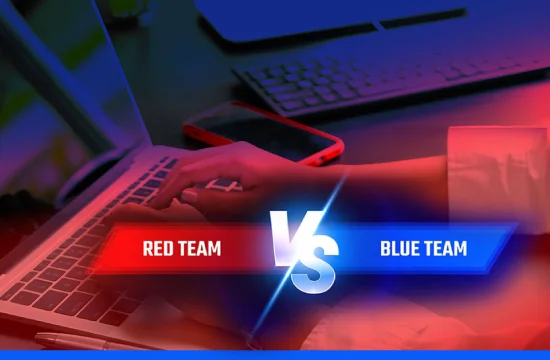What is Red Team vs Blue Team in Cybersecurity?
Red Team vs Blue Team in cybersecurity refers to a structured approach used by organizations to assess and improve their security posture. The concept is based on the idea of having two opposing groups, each with distinct roles, working against each other to simulate real-world cyber threats and defense mechanisms. The Red Team operates as the attackers, attempting to exploit vulnerabilities in a system, while the Blue Team serves as the defenders, working to detect, mitigate, and prevent attacks.
The Red Team is composed of ethical hackers and penetration testers who think and act like cybercriminals. Their primary goal is to identify weaknesses in an organization's security infrastructure by using tactics such as social engineering, phishing, network penetration, and malware deployment. By adopting an offensive mindset, the Red Team helps organizations uncover security gaps that might otherwise go unnoticed. They often use advanced tools and techniques similar to those employed by actual threat actors, allowing businesses to understand their weaknesses before a real attacker exploits them.
On the other side, the Blue Team is responsible for defending the organization’s systems, networks, and data against attacks. These cybersecurity professionals monitor for potential threats, analyze attack patterns, and implement security measures to protect the organization. Their work involves threat detection, incident response, security information and event management (SIEM),endpoint protection, and forensic analysis. By continuously refining security protocols and responding to simulated attacks, the Blue Team enhances the organization’s ability to defend against real-world threats.
The interaction between the Red Team and Blue Team is essential for strengthening an organization’s overall cybersecurity strategy. Red Teams expose vulnerabilities, allowing Blue Teams to refine their detection and response capabilities. This cycle of attack and defense creates a proactive security culture, ensuring that security teams remain prepared for evolving cyber threats. In some cases, organizations integrate a Purple Team, which acts as a bridge between the Red and Blue Teams. The Purple Team fosters collaboration, ensuring that the insights gained from Red Team attacks directly enhance Blue Team defenses.
One of the key benefits of Red Team vs Blue Team exercises is that they provide a realistic assessment of an organization’s security readiness. Traditional security assessments often rely on audits and compliance checks, but Red and Blue Teaming delivers hands-on testing that mirrors real-world cyber threats. This approach helps organizations identify vulnerabilities, improve response strategies, and ultimately reduce their overall risk exposure. Regular Red vs Blue Team exercises allow companies to stay ahead of cybercriminals, ensuring that security teams are well-prepared for actual attacks.
Red Team: Offensive Security Tactics
Red Teaming is a proactive cybersecurity approach where ethical hackers, security researchers, and penetration testers simulate real-world cyberattacks to uncover vulnerabilities in an organization's defenses. Operating as adversaries, the Red Team’s primary objective is to think and act like malicious hackers, exploiting weaknesses in systems, networks, applications, and human behaviors. By mimicking the techniques used by actual cybercriminals, Red Teams provide organizations with a realistic assessment of their security posture.
Red Team operations typically begin with reconnaissance, where they gather intelligence on the target organization, its infrastructure, and potential attack vectors. This phase involves passive and active information gathering, such as scanning public databases, monitoring social media, and probing network endpoints for exploitable weaknesses. Once the Red Team identifies potential entry points, they move into the exploitation phase, where they attempt to breach security defenses. They may deploy tactics such as phishing attacks, credential stuffing, SQL injection, or exploiting software vulnerabilities to gain unauthorized access.
Social engineering is another key offensive security tactic used by Red Teams. Since human error remains one of the most significant security risks, Red Teams often conduct phishing campaigns, impersonate employees or vendors, and manipulate users into revealing sensitive information. By testing an organization's ability to recognize and respond to social engineering threats, they help improve employee awareness and training programs.
Once inside the network, Red Teams focus on lateral movement, privilege escalation, and persistence. They use tools such as PowerShell scripting, malware payloads, and credential harvesting techniques to navigate through systems, elevate their access, and establish long-term control over compromised environments. The ultimate goal is to assess how far an attacker can penetrate before being detected and how much damage they could potentially cause. This phase may involve exfiltrating sensitive data, deploying ransomware simulations, or disrupting critical operations to gauge the organization's response readiness.
Red Team engagements conclude with a detailed report highlighting exploited vulnerabilities, attack paths, and security gaps. More importantly, they provide recommendations on improving security defenses, hardening systems, and strengthening incident response protocols. Unlike traditional penetration testing, which often follows a checklist-based assessment, Red Teaming is dynamic and adaptive, reflecting the constantly evolving tactics of real-world adversaries.
By regularly conducting Red Team exercises, organizations can identify weaknesses before attackers do, enhance their detection and response capabilities, and continuously improve their security posture. This offensive approach ensures that security teams remain vigilant, proactive, and prepared for the growing threats posed by cybercriminals.
Blue Team: Defensive Security Strategies
The Blue Team is responsible for defending an organization’s systems, networks, and data against cyber threats. Unlike the Red Team, which operates offensively to simulate attacks, the Blue Team focuses on detection, response, and mitigation to protect assets from real-world cyberattacks. Their primary goal is to create a resilient security posture by implementing defensive strategies, monitoring threats, and responding to incidents effectively.
A strong Blue Team starts with robust security policies and frameworks. This includes setting up access controls, enforcing least privilege principles, and implementing network segmentation to minimize the risk of lateral movement during an attack. They also focus on vulnerability management by continuously patching software, updating configurations, and conducting security audits to identify and remediate potential weaknesses before they can be exploited.
Threat detection is a core function of Blue Teams. They utilize advanced tools such as Security Information and Event Management (SIEM) systems, Endpoint Detection and Response (EDR) solutions, and Intrusion Detection and Prevention Systems (IDPS) to monitor network activity and identify suspicious behavior. By leveraging threat intelligence feeds and machine learning-based anomaly detection, Blue Teams can proactively spot indicators of compromise (IoCs) and take swift action to contain threats.
Incident response and containment are crucial defensive strategies. When a cyberattack occurs, the Blue Team follows predefined incident response playbooks to analyze the threat, isolate affected systems, and mitigate further damage. This involves conducting forensic investigations to determine the attack’s origin, assessing the extent of the breach, and implementing remediation measures to prevent recurrence. Effective incident response minimizes downtime, reduces financial losses, and prevents data breaches from escalating.
Security awareness and training are also integral to Blue Team operations. Since human error is a common attack vector, Blue Teams conduct regular cybersecurity training programs, phishing simulations, and tabletop exercises to educate employees on recognizing and responding to cyber threats. By fostering a culture of security awareness, organizations can significantly reduce the risk of successful social engineering attacks.
Continuous improvement is a key philosophy of Blue Teams. By analyzing past incidents, learning from Red Team exercises, and adapting to emerging cyber threats, they refine their defense strategies over time. Security teams also conduct penetration testing and adversary emulation exercises to test their resilience against real-world attack scenarios, ensuring that defensive mechanisms remain effective.
A well-equipped Blue Team plays a vital role in an organization’s cybersecurity ecosystem. By maintaining a proactive security posture, staying ahead of evolving threats, and responding efficiently to incidents, they help safeguard critical data, ensure business continuity, and fortify defenses against cyber adversaries.






